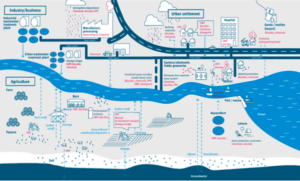Challenge 2
Micropollutants and water quality.
The German Environmental Agency defines micropollutants as ‘’substances that are generally present in water bodies in low concentrations.
Micropollutants
Known for being ubiquitous and having the ability to impact negatively on aquatic environments, the German Environmental Agency defines micropollutants as ‘’substances that are generally present in water bodies in low concentrations (typically in the range of ng–µg/l) but which can have detrimental effects on humans, the environment or drinking water supplies in these concentrations’’ (Athing et al., 2018). The main entry paths of micropollutants into aquatic environments include a gamut of sources not limited to sewage disposal, agriculture, mining, hospitals and the pharmaceutical industry. The micropollutants including personal care products, disinfectants, antiseptics, heavy metals, pharmaceuticals, pesticides and biocides emanating from these sources have the potential of persisting in aquatic environments ultimately dissolving in acidic water, precipitating in hard water, bioaccumulating in aquatic organisms and biomagnifying along food chains (Antakyali et al., 2015; Jaiswal et al., 2018; Peralta-Maraver et al., 2019).
Even though there is extensive literature on the impacts of inorganic micropollutants namely mercury, lead, cadmium and arsenic on ecosystems, aquatic environments and human health based on their extremely toxic and degradation resistant properties (Gheorghe et al., 2017; Jaiswal et al., 2018; Bedu-Addo et al., 2019; Sall et al., 2020), impacts of the organic micropollutants not limited to hormones, antibiotics, cosmetics, fragrances, insect repellents and sun-screen agents remains a paucity.
A significant quantity of common organic micropollutants namely endocrine disrupting compounds (hormones, synthetic fragrances, plasticizers, perfluorinated compounds), biocides (herbicides, (disinfectants, antiseptics, pesticides, fungicides) aromatic hydrocarbons (benzene, toluene, ethylbenzene, xylene), pharmaceuticals and personal care products get to water bodies through municipal wastewater treatment plants. This makes municipal wastewater treatment plants a very important source of micropollutant that pollute aquatic environments (Antakyali et al., 2015; Athing et al., 2018). Identifying the drivers that generate pressures in the form of organic and inorganic microllutants, which may change the state of water bodies ultimately leading to impacts such as sex change, reduced vision, reduced osmoregulation and reproduction in aquatic organisms (Zanuri et al., 2017; Bonnefille et al., 2018) is worth investigating in contemporary times.

References
Athing M., Brauer F., Duffek A., Ebert I., Eckhardt A., Hassold E., Helmecke M., Kirst I., Krause B. and
Lepom P. (2018) Recommendations for reducing micropollutants in waters. German Environment Agency.
Antakyali D., Morgenschweis C., De Kort T., Sasse R., Schulz J. and Herbst H. (2015) Micropollutants
in the aquatic environment and their removal in wastewater treatment works. 9th European Waste Water Management Conference, Manchester UK.
Bedu-Addo K., Ofori-Kuragu M. and Arthur Jr A. (2019) The AKOBEN programme as a tool towards
responsible gold mining in Ghana, business as usual or a commitment towards sustainable development. Heliyon 5(6), e01925.
Bonnefille, B., Gomez, E., Alali, M., Rosain, D., Fenet, H., & Courant, F. (2018) Metabolomics
assessment of the effects of diclofenac exposure on Mytilus galloprovincialis: Potential effects on osmoregulation and reproduction. Science of The Total Environment, 613(1), 611–618.
Gheorghe S., Stoica C., Vasile G.G., Nita-Lazar M., Stanescu E. and Lucaciu I.E. (2017) Metals toxic
effects in aquatic ecosystems: modulators of water quality. Water quality 60-89.
Jaiswal, A., Verma, A., & Jaiswal, P. (2018). Detrimental effects of heavy metals in soil, plants, and
aquatic ecosystems and in humans. Journal of Environmental Pathology, Toxicology and Oncology, 37(3), 183-197.
Peralta-Maraver I., Posselt M., Perkins D.M. and Robertson A.L. (2019) Mapping Micro-Pollutants
and Their Impacts on the Size Structure of Streambed Communities. Water 11(12), 2610.
Sall M.L., Diaw A.K.D., Gningue-Sall D., Efremova Aaron S. and Aaron J.J. (2020) Toxic heavy metals:
impact on the environment and human health, and treatment with conducting organic polymers, a review. Environmental Science and Pollution Research 27, 29927-29942.
Zanuri, N. B. M., Bentley, M. G., & Caldwell, G. S. (2017) Assessing the impact of diclofenac,
ibuprofen and sildenafil citrate (Viagra®) on the fertilisation biology of broadcast spawning marine invertebrates. Marine environmental research, 127(1), 126-136.
About
Dr. Kenneth Bedu-Addo
School of Engineering and Architecture
SRH Hochschule Heidelberg
Bonhoefferstr. 11
69123 Heidelberg
